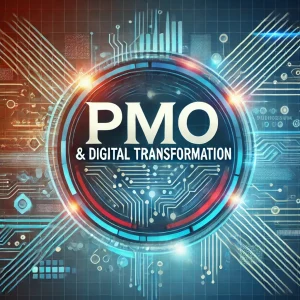
The Key to Unlocking Digital Success Lies in the PMO
Your organization is undertaking a digital transformation, but despite the investments, progress is slow, and results seem elusive. Projects are falling behind schedule, objectives are becoming less clear, and the anticipated benefits are nowhere in sight. Could the solution lie within an often-underappreciated entity: the Project Management Office (PMO)?
The PMO is often seen as a tactical entity that ensures projects run smoothly. However, the PMO’s role has evolved. It’s not just about project management anymore, it’s also about driving transformation.
Why This Matters Now More Than Ever
As businesses adopt new technologies at a staggering pace, there’s a growing disconnect between technical solutions and business goals. Organizations pour resources into tech-driven projects, only to see them fall short of expectations. Why? The answer often lies in misalignment, tech teams focus on innovation, while business leaders are left trying to make sense of it all.
This misalignment creates inefficiencies, wasted resources, and frustrated stakeholders. And this is where the PMO steps in, not just as a project manager but as a strategic enabler that aligns tech initiatives with business goals.
How the PMO Can Align Technology with Business Objectives
The PMO is uniquely positioned to act as the glue between technology and business strategy. Here are five key strategies for how the PMO can bridge this gap:
- Facilitating Clear Communication Between Teams
One of the biggest hurdles in digital transformation is communication. Tech teams often speak a different language than business leaders. The PMO can ensure that both sides are aligned by translating technical jargon into clear business benefits and vice versa. Regular check-ins, structured communication plans, and clear reporting lines can make all the difference. - Ensuring Projects Are Aligned with Business Goals
The PMO must go beyond managing tasks and timelines. It should proactively ensure that every project aligns with broader business objectives. This means having a clear understanding of the organization’s strategic goals and ensuring that tech initiatives contribute directly to achieving them. Projects that don’t align should either be adjusted or halted. - Managing Organizational Change Effectively
Digital transformation is as much about people as it is about technology. Change management is a crucial component, and the PMO can lead this charge. By working closely with HR and department heads, the PMO can help guide teams through transitions, reduce resistance, and foster a culture that embraces innovation. - Driving Agile Methodologies for Flexibility
The PMO can adopt agile methodologies to ensure flexibility and rapid response to changing business needs. By breaking down projects into smaller, manageable parts and focusing on iterative development, the PMO ensures that digital initiatives remain adaptable and relevant. - Measuring and Communicating the Value of Digital Projects
Business leaders want to see tangible outcomes from digital investments. The PMO can track and measure the performance of digital projects, not just in terms of technical success, but in terms of business value—whether that’s improved customer satisfaction, revenue growth, or operational efficiencies. Regular updates and transparent metrics ensure that stakeholders are always in the loop.
From Tactical to Strategic: Why the PMO’s Role Is Essential
The PMO is no longer just a back-office function. It’s a critical player in driving digital transformation and ensuring that tech initiatives not only run smoothly but also deliver real business value. Organizations that empower their PMOs to take on this strategic role are more likely to see their digital efforts pay off.
Next Steps: Transform Your PMO into a Strategic Enabler
To truly leverage the PMO’s potential, organizations need to shift their perspective. The PMO should be empowered, not only to manage projects but to strategically guide digital transformation efforts. Encourage your PMO to focus on business outcomes, foster cross-departmental collaboration, and become the bridge between technology and strategy.
Drive Transformation through Alignment
The PMO holds the key to ensuring that digital transformation efforts are successful. By aligning technology initiatives with business objectives, managing change effectively, and communicating the value of digital projects, the PMO can bridge the gap between tech and strategy.
